SEDIS—A Rumor Propagation Model for Social Networks by Incorporating the Human Nature of Selection
Abstract
1. Introduction
- 1.
- S: Susceptible node—refers to the nodes susceptible to getting infected.
- 2.
- I: Infected nodes—nodes that are infected and are capable of spreading disease (rumors) to the susceptible ones.
- 3.
- R: Recovered nodes—nodes recovered from infection by attaining immunity or recovered due to death.
- is the probability of meeting a susceptible one at a random unit of time.
- is the average number of susceptible populations that infected nodes meet per unit time.
- is the average number of susceptible people infected from all infected per unit time.
2. Problem Statement and Contributions
2.1. Problem Statement
2.2. Contributions
- Created a mathematical rumor propagation model by considering that the Recovered state is not practically possible in networks.
- Included a new state for social network rumor propagation by considering the human psychological aspect of social selection and current trends in society.
3. The SEDIS Model
Rumor Propagation Model
- Susceptible users are the individuals on social media who have a chance to meet an Infected node—that is, the one who shares a rumor.
- Exposed ones are the individuals who have seen the rumors shared by the users from their contact/ following list.
- A susceptible node is likely to meet an infected node and may become exposed at probability α.
- Under certain probability, an exposed individual can either become a doubter or infected at probability β1 and β2, respectively.
- An exposed individual can reject a rumor and may go back to the susceptible state at probability µ1.
- The doubter state refers to doubters who are doubtful whether a piece of information propagated towards them is genuine or not. These individuals can become infected at probability ϒ or return to the susceptible state at probability µ2.
- There is no recovery stage. However, an infected individual may return to the susceptible stage at probabilityµ3.
4. Method
4.1. Discrete Compartment Modeling
- is the probability of meeting a susceptible one at a random unit of time.
- is the average number of infected people becoming susceptible from all infected per unit time.
- is the average number of doubters becoming susceptible from all doubters per unit time.
- is the average number of exposed people returning to the susceptible state from all exposed people per unit time.
- is the average number of susceptible people becoming exposed from all susceptible per unit time.
4.2. Analyzing the Model through R
| Algorithm 1 Algorithm for the SEDIS Model | |
| Require: Probability for susceptible to exposed state α | |
| Probability for the exposed state to the doubter state β1 | |
| Probability for the exposed state to the infected state β2 | |
| Probability for the doubter state to the infected state ϒ | |
| Probability for the exposed state to the susceptible state µ1 | |
| Probability for the doubter state to the susceptible state µ2 | |
| Probability for the infected state to susceptible state µ3 | |
| State of nodes: State | |
| Node of the susceptible state = S | |
| Node of the exposed state = E | |
| Node of the doubter state = D | |
| Node of the infected state = I | |
| Ensure: State of nodes after time interval t: state | |
| 1: | Generating scale-free network adjacent matrix A |
| 2: | Initialization: original state: stat = [S,E,D,I] |
| 3: | while interval < t do |
| 4: | for i = 1: n do |
| 5: | Switch state(st) |
| 6: | case S: transfer to E with α |
| 7: | case E: transfer to D with β1, I with β2 and S with µ1 |
| 8: | case D: transfer to I with ϒ and to S with µ2 |
| 9: | case I: transfer to S with µ3 |
| 10: | end Switch |
| 11: | end for |
| 12: | end while |
| 13: | Return state |
5. Properties of the System
6. Analysis and Results
7. Discussion
8. Conclusions and Future Scope
Author Contributions
Funding
Institutional Review Board Statement
Informed Consent Statement
Data Availability Statement
Conflicts of Interest
References
- McIntyre, K.E. The evolution of social media from 1969 to 2013: A change in competition and a trend toward complementary, niche sites. J. Soc. Media Soc. 2014, 3, 5–25. [Google Scholar]
- Kim, J.H.; Bock, G.W. A Study on The Factors Affecting the Behavior of Spreading Online Rumors: Focusing on the Rumor Recipient’s Emotions. PACIS 2011, 98. [Google Scholar]
- Woodruff, A. Necessary, unpleasant, and disempowering: Reputation management in the internet age. In Proceedings of the SIGCHI Conference on Human Factors in Computing Systems, New York, NY, USA, 26 April 2014; pp. 149–158. [Google Scholar] [CrossRef]
- Horn, I.S.; Taros, T.; Dirkes, S.; Hüer, L.; Rose, M.; Tietmeyer, R.; Constantinides, E. Business reputation and social media: A primer on threats and responses. J. Direct Data Digit. Mark. Pract. 2015, 16, 193–208. [Google Scholar] [CrossRef]
- Nakano, T.; Suda, T.; Okaie, Y.; Moore, M.J. Analysis of Cyber Aggression and Cyber-Bullying in Social Networking. In Proceedings of the 2016 IEEE Tenth International Conference on Semantic Computing (ICSC), Laguna Hills, CA, USA, 4–6 February 2016; pp. 337–341. [Google Scholar] [CrossRef]
- Alotaibi, N.B. Cyber Bullying and the Expected Consequences on the Students’ Academic Achievement. IEEE Access 2019, 7, 153417–153431. [Google Scholar] [CrossRef]
- Al-Yazidi, S.; Berri, J.; Al-Qurishi, M.; Al-Alrubaian, M. Measuring Reputation and Influence in Online Social Networks: A Systematic Literature Review. IEEE Access 2020, 8, 105824–105851. [Google Scholar] [CrossRef]
- Alsawalqa, R.O. Cyberbullying, social stigma, and self-esteem: The impact of COVID-19 on students from East and Southeast Asia at the University of Jordan. Heliyon 2021, 7, e06711. [Google Scholar] [CrossRef] [PubMed]
- Han, Z.; Wang, Z.; Li, Y. Cyberbullying Involvement, Resilient Coping, and Loneliness of Adolescents During COVID-19 in Rural China. Front. Psychol. 2021, 12, 664612. [Google Scholar] [CrossRef] [PubMed]
- Mumtaz, N.; Green, C.; Duggan, J. Exploring the Effect of Misinformation on Infectious Disease Transmission. Systems 2022, 10, 50. [Google Scholar] [CrossRef]
- Albert, R.; Barabási, A.L. Statistical mechanics of complex networks. Rev. Mod. Phys. 2002, 74, 47. [Google Scholar] [CrossRef]
- Kermack, W.O.; McKendrick, A.G. A contribution to the mathematical theory of epidemics. Proc. R. Soc. London. Ser. A Math. Phys. Sci. 1927, 115, 700–721. [Google Scholar] [CrossRef]
- Bao, Y.; Yi, C.; Xue, Y.; Dong, Y. A new rumor propagation model and control strategy on social networks. In Proceedings of the 2013 IEEE/ACM International Conference on Advances in Social Networks Analysis and Mining (ASONAM 2013), Niagara Falls, ON, Canada, 25–28 August 2013; pp. 1472–1473. [Google Scholar] [CrossRef]
- Sumith, N.; Annappa, B.; Bhattacharya, S. RnSIR: A new model of information spread in online social networks. In Proceedings of the 2016 IEEE Region 10 Conference (TENCON), Singapore, 22–25 November 2016; pp. 2224–2227. [Google Scholar] [CrossRef]
- Han, Q.; Wen, H.; Miao, F. Rumor spreading in interdependent social networks. Peer-To-Peer Netw. Appl. 2018, 11, 955–965. [Google Scholar] [CrossRef]
- Jain, L.; Katarya, R.; Sachdeva, S. Role of Opinion Leader for the diffusion of products using Epidemic model in Online Social Network. In Proceedings of the 2019 Twelfth International Conference on Contemporary Computing (IC3), Noida, India, 8–10 August 2019; pp. 1–6. [Google Scholar] [CrossRef]
- Fang, M.; Li, L.-N.; Yang, L. Social Network Public Opinion Research Based on S-SEIR Epidemic Model. In Proceedings of the 2019 IEEE International Conference on Cloud Computing Technology and Science (CloudCom), Sydney, NSW, Australia, 11–13 December 2019; IEEE Computer Society: Washington, DC, USA; pp. 374–379. [Google Scholar] [CrossRef]
- Keshri, A.K.; Mishra, B.K.; Rukhaiyar, B.P. When rumors create chaos in e-commerce. Chaos Solitons Fractals 2020, 131, 109497. [Google Scholar] [CrossRef]
- Ghazzali, R.; El Bhih, A.; Laaroussi, A.E.A.; Rachik, M. Modeling a Rumor Propagation in Online Social Network: An Optimal Control Approach. Discret. Dyn. Nat. Soc. 2020, 2020, 6724815. [Google Scholar] [CrossRef]
- Das Swain, V.; Saha, K.; Abowd, G.D.; De Choudhury, M. Social Media and Ubiquitous Technologies for Remote Worker Wellbeing and Productivity in a Post-Pandemic World. In Proceedings of the IEEE Second International Conference on Cognitive Machine Intelligence (CogMI) 2020, Atlanta, GA, USA, 28–31 October 2020; pp. 121–130. [Google Scholar] [CrossRef]
- Shrivastava, G.; Kumar, P.; Ojha, R.P.; Srivastava, P.K.; Mohan, S.; Srivastava, G. Defensive Modeling of Fake News through Online Social Networks. IEEE Trans. Comput. Soc. Syst. 2020, 7, 1159–1167. [Google Scholar] [CrossRef]
- Yu, Z.; Lu, S.; Wang, D.; Li, Z. Modeling and analysis of rumor propagation in social networks. Inf. Sci. 2021, 580, 857–873. [Google Scholar] [CrossRef]
- Narayan, N.; Jha, R.K.; Singh, A. A SEIS Criss-Cross Model for Online Social Networks Communities. Commun. Math. Appl. 2021, 12, 711–721. [Google Scholar] [CrossRef]
- Ardèvol-Abreu, A.; Delponti, P.; Rodríguez-Wangüemert, C. Intentional or inadvertent fake news sharing? Fact-checking warnings and users’ interaction with social media content. El Prof. De La Inf. 2020, 29. [Google Scholar] [CrossRef]
- Dumitru, E.-A. Testing Children and Adolescents’ Ability to Identify Fake News: A Combined Design of Quasi-Experiment and Group Discussions. Societies 2020, 10, 71. [Google Scholar] [CrossRef]
- Bass, H. ABA Legal Fact Check sorts truth from fiction on legal issues. ABA J. 2018, 104, 2. [Google Scholar]
- Swift, J. CHECKING THE FACTS: Newspapers are fighting harder than ever against the spread of misinformation. Ed. Publ. 2018, 151, 38–43. [Google Scholar]
- Indian Government Could Shut Down Apps and Websites Spreading Fake News and Child Pornography. FRPT- Software Snapshot, Digit. 6–7; 2019. Available online: https://www.digit.in/news/general/indian-government-could-shut-down-apps-and-websites-spreading-fake-news-and-child-pornography-45600.html (accessed on 28 November 2022).
- Diekmann, O.; Heesterbeek, J.A.P.; Roberts, M.G. The construction of next-generation matrices for compart-mental epidemic models. J. R. Soc. Interface 2010, 7, 873–885. [Google Scholar] [CrossRef] [PubMed]
- Dong, S.; Deng, Y.-B.; Huang, Y.-C. SEIR Model of Rumor Spreading in Online Social Network with Varying Total Population Size. Commun. Theor. Phys. 2017, 68, 545. [Google Scholar] [CrossRef]
- Grabowski, A.; Kosiński, R. The SIRS Model of Epidemic Spreading in Virtual Society. Acta Phys. Pol. A 2008, 114, 589–596. [Google Scholar] [CrossRef]
- Smith, M.A.; Rainie, L.; Shneiderman, B.; Himelboim, I. Mapping Twitter Topic Networks: From Polarized Crowds to Community Clusters; Pew Research Center, Internet, Science & Tech.: Washington, DC, USA, 2014. [Google Scholar]
- Choi, E.; Park, N. Can Online Education Programs Solve the Cyberbullying Problem? Educating South Korean El-ementary Students in the COVID-19 Era. Sustainability 2021, 13, 11211. [Google Scholar] [CrossRef]
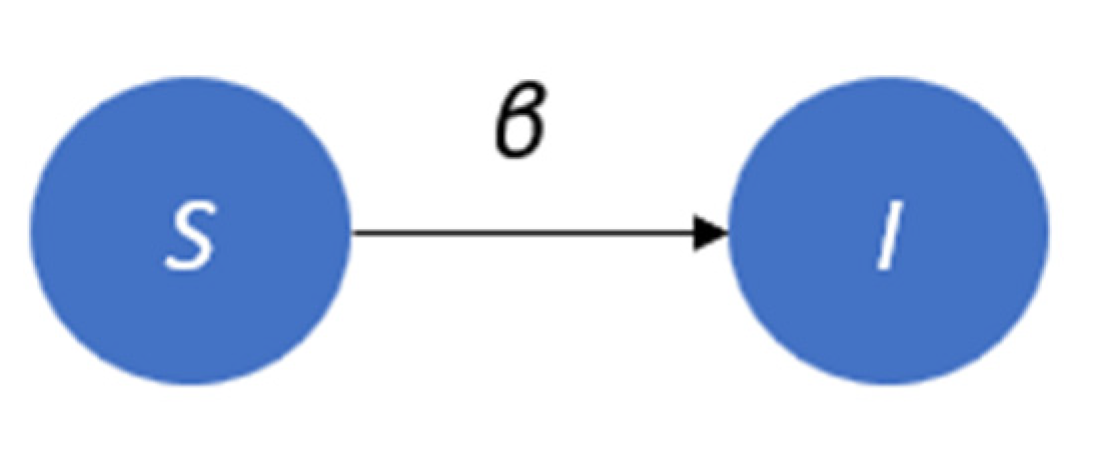

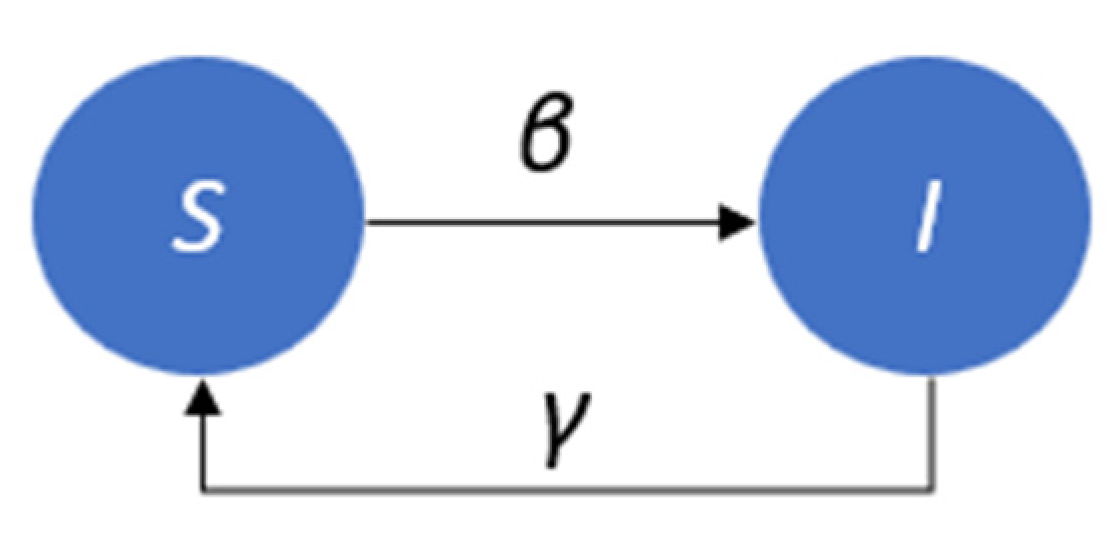

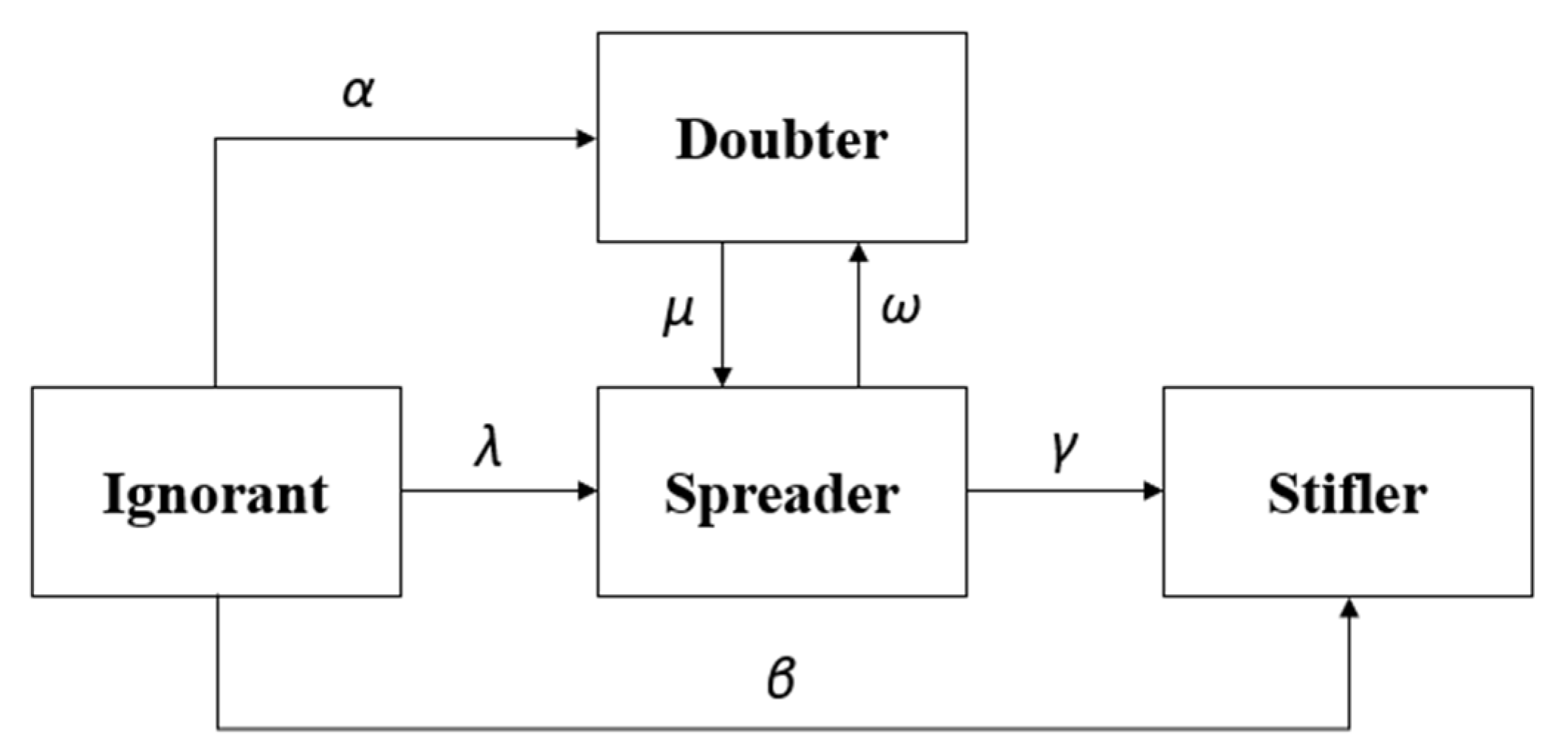

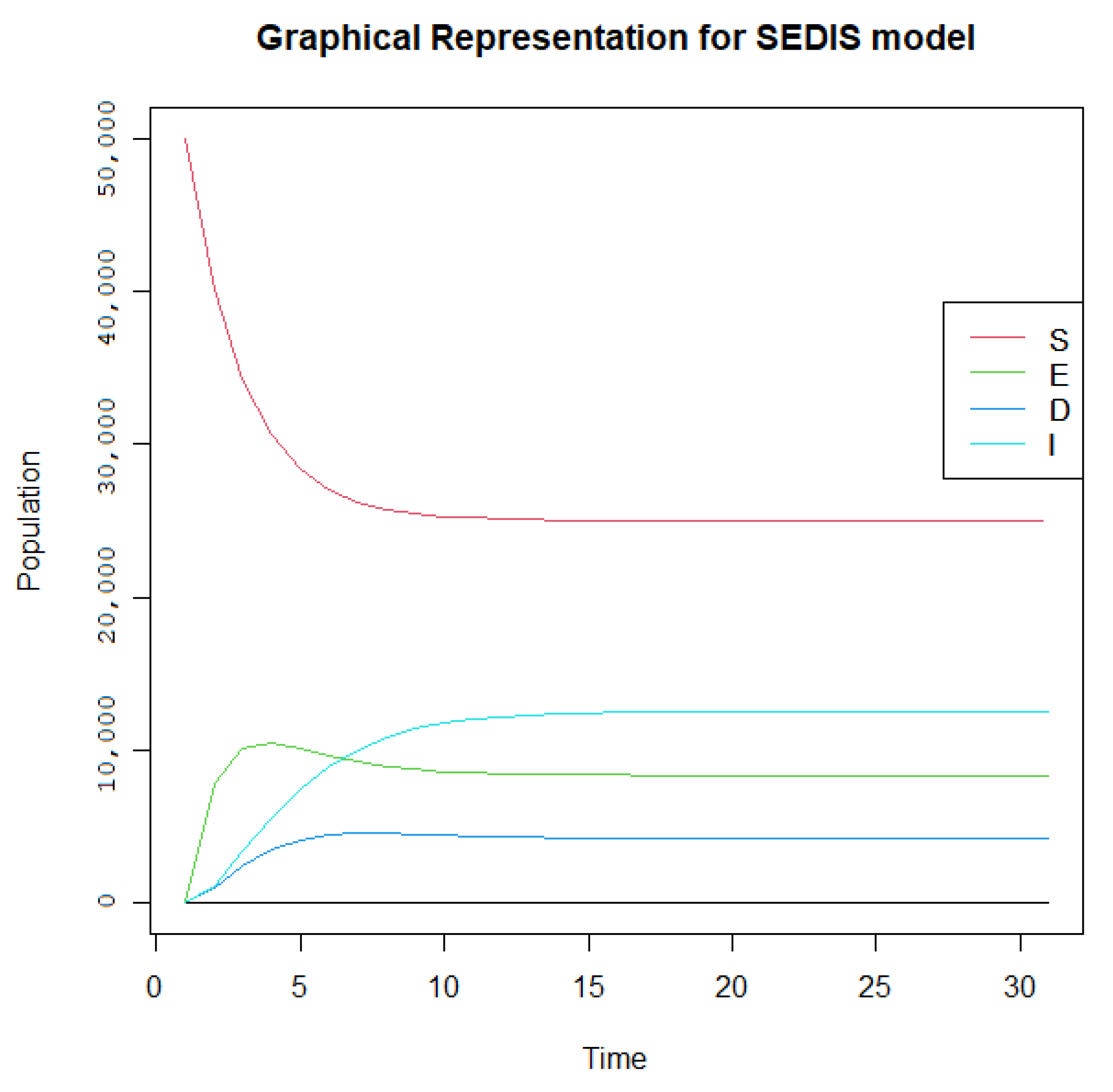
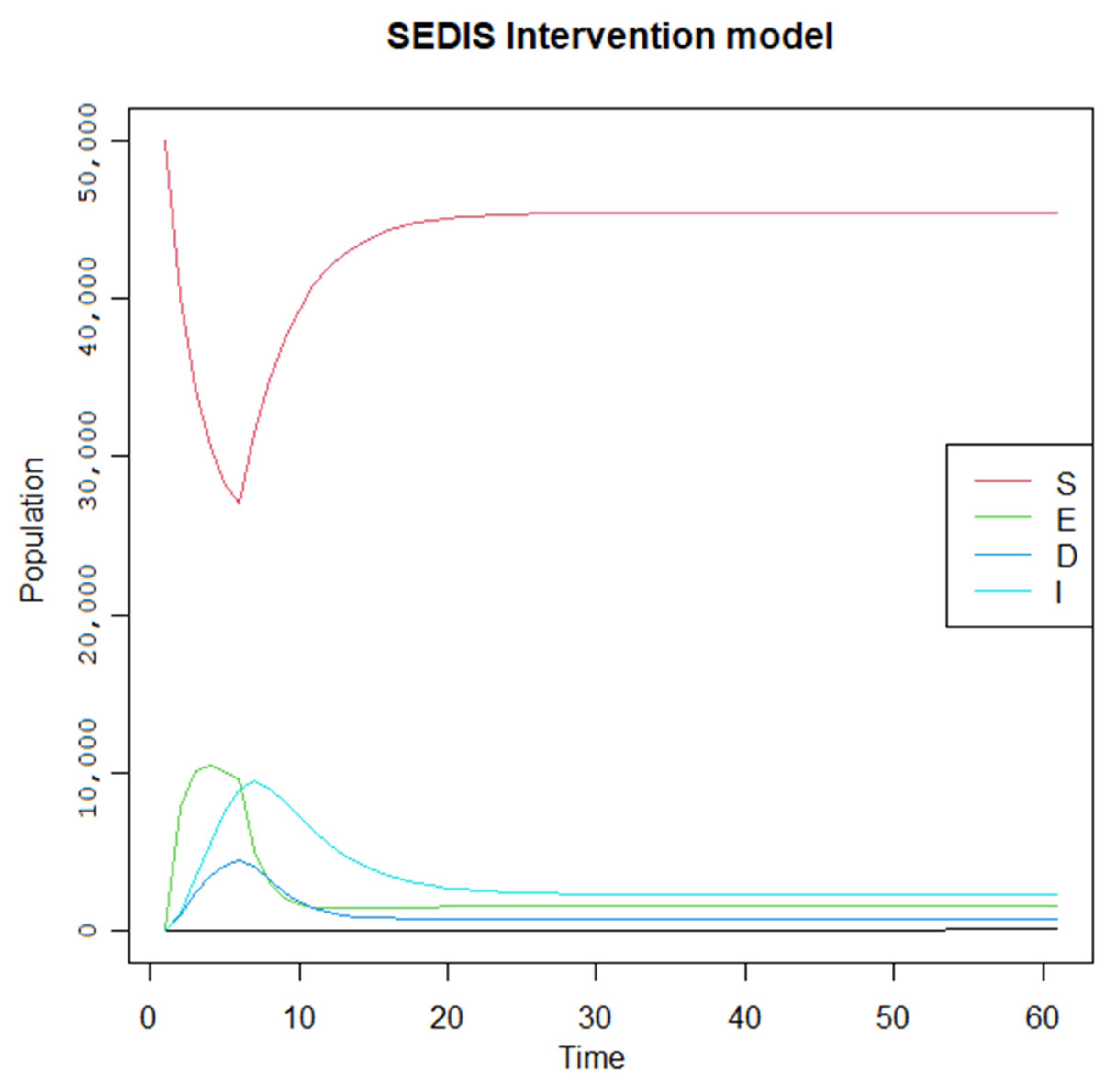
| Parameter | Physical Interpretation |
|---|---|
| S | Susceptible compartment |
| E | Exposed compartment |
| D | Doubter compartment |
| I | Infected compartment |
| α | Probability of transition from the susceptible to the exposed state |
| β1 | Probability of transition from the exposed to the doubter state |
| β2 | Probability of transition from the exposed to the infected state |
| ϒ | Probability of transition from the doubter to the infected state |
| µ1 | Probability of transition from the exposed to the infected state |
| µ2 | Probability of transition from the doubter to the susceptible state |
| µ3 | Probability of transition from the infected to the susceptible state |
| Day | S | E | D | I |
|---|---|---|---|---|
| 0 | 49,999 | 1 | 0 | 0 |
| 1 | 40,163 | 7751 | 958 | 1128 |
| 2 | 34,197 | 10,093 | 2407 | 3303 |
| 3 | 30,578 | 10,398 | 3496 | 5527 |
| 4 | 28,383 | 10,057 | 4135 | 7425 |
| 5 | 27,052 | 9601 | 4438 | 8909 |
| 6 | 26,245 | 9208 | 4537 | 10,011 |
| 7 | 25,755 | 8913 | 4530 | 10,801 |
| 8 | 25,458 | 8709 | 4478 | 11,355 |
| 9 | 25,278 | 8572 | 4414 | 11,736 |
| 10 | 25,168 | 8483 | 4354 | 11,995 |
| 11 | 25,102 | 8427 | 4303 | 12,168 |
| 12 | 25,062 | 8391 | 4264 | 12,283 |
| 13 | 25,038 | 8369 | 4234 | 12,359 |
| 14 | 25,023 | 8355 | 4213 | 12,409 |
| 15 | 25,014 | 8347 | 4198 | 12,441 |
| 16 | 25,008 | 8342 | 4188 | 12,462 |
| 17 | 25,005 | 8338 | 4181 | 12,476 |
| 18 | 25,003 | 8336 | 4176 | 12,485 |
| 19 | 25,002 | 8335 | 4173 | 12,490 |
| 20 | 25,001 | 8334 | 4171 | 12,494 |
| 21 | 25,001 | 8334 | 4169 | 12,496 |
| 22 | 25,000 | 8334 | 4168 | 12,497 |
| 23 | 25,000 | 8334 | 4168 | 12,498 |
| 24 | 25,000 | 8333 | 4167 | 12,499 |
| 25 | 25,000 | 8333 | 4167 | 12,499 |
| 26 | 25,000 | 8333 | 4167 | 12,500 |
| 27 | 25,000 | 8333 | 4167 | 12,500 |
| 28 | 25,000 | 8333 | 4167 | 12,500 |
| 29 | 25,000 | 8333 | 4167 | 12,500 |
| 30 | 25,000 | 8333 | 4167 | 12,500 |
| Day | S | E | D | I |
|---|---|---|---|---|
| 0 | 49,999 | 1 | 0 | 0 |
| 1 | 40,163 | 7751 | 958 | 1128 |
| 2 | 34,197 | 10,093 | 2407 | 3303 |
| 3 | 30,578 | 10,398 | 3496 | 5527 |
| 4 | 28,383 | 10,057 | 4135 | 7425 |
| 5 | 27,052 | 9601 | 4438 | 8909 |
| 6 | 31,477 | 5057 | 4040 | 9427 |
| 7 | 34,837 | 2977 | 3197 | 8989 |
| 8 | 37,390 | 2045 | 2413 | 8152 |
| 9 | 39,329 | 1644 | 1818 | 7210 |
| 10 | 40,802 | 1483 | 1406 | 6309 |
| 11 | 41,920 | 1430 | 1138 | 5512 |
| 12 | 42,770 | 1421 | 970 | 4838 |
| 13 | 43,415 | 1430 | 869 | 4285 |
| 14 | 43,906 | 1444 | 810 | 3840 |
| 15 | 44,278 | 1458 | 777 | 3487 |
| 16 | 44,561 | 1470 | 759 | 3209 |
| 17 | 44,776 | 1481 | 751 | 2993 |
| 18 | 44,939 | 1489 | 748 | 2825 |
| 19 | 45,063 | 1495 | 747 | 2695 |
| 20 | 45,157 | 1500 | 748 | 2596 |
| 21 | 45,229 | 1503 | 749 | 2519 |
| 22 | 45,283 | 1506 | 750 | 2461 |
| 23 | 45,324 | 1508 | 752 | 2416 |
| 24 | 45,356 | 1510 | 753 | 2382 |
| 25 | 45,379 | 1511 | 754 | 2356 |
| 26 | 45,397 | 1512 | 755 | 2336 |
| 27 | 45,411 | 1513 | 755 | 2321 |
| 28 | 45,422 | 1513 | 756 | 2309 |
| 29 | 45,430 | 1514 | 756 | 2300 |
| 30 | 45,436 | 1514 | 757 | 2294 |
| Model | Time t (days) | Susceptible Population | Infected Population |
|---|---|---|---|
| SI Model | 0 | 49,999 | 1 |
| 30 | 28 | 49,972 | |
| SIS Model | 0 | 49,999 | 1 |
| 30 | 25,000 | 25,000 | |
| SEIS Model | 0 | 49,999 | 1 |
| 30 | 16,667 | 16,666 | |
| SEDIS Model | 0 | 49,999 | 1 |
| 30 | 25,000 | 12,500 |
Disclaimer/Publisher’s Note: The statements, opinions and data contained in all publications are solely those of the individual author(s) and contributor(s) and not of MDPI and/or the editor(s). MDPI and/or the editor(s) disclaim responsibility for any injury to people or property resulting from any ideas, methods, instructions or products referred to in the content. |
© 2022 by the authors. Licensee MDPI, Basel, Switzerland. This article is an open access article distributed under the terms and conditions of the Creative Commons Attribution (CC BY) license (https://creativecommons.org/licenses/by/4.0/).
Share and Cite
Govindankutty, S.; Gopalan, S.P. SEDIS—A Rumor Propagation Model for Social Networks by Incorporating the Human Nature of Selection. Systems 2023, 11, 12. https://doi.org/10.3390/systems11010012
Govindankutty S, Gopalan SP. SEDIS—A Rumor Propagation Model for Social Networks by Incorporating the Human Nature of Selection. Systems. 2023; 11(1):12. https://doi.org/10.3390/systems11010012
Chicago/Turabian StyleGovindankutty, Sreeraag, and Shynu Padinjappurathu Gopalan. 2023. "SEDIS—A Rumor Propagation Model for Social Networks by Incorporating the Human Nature of Selection" Systems 11, no. 1: 12. https://doi.org/10.3390/systems11010012
APA StyleGovindankutty, S., & Gopalan, S. P. (2023). SEDIS—A Rumor Propagation Model for Social Networks by Incorporating the Human Nature of Selection. Systems, 11(1), 12. https://doi.org/10.3390/systems11010012






